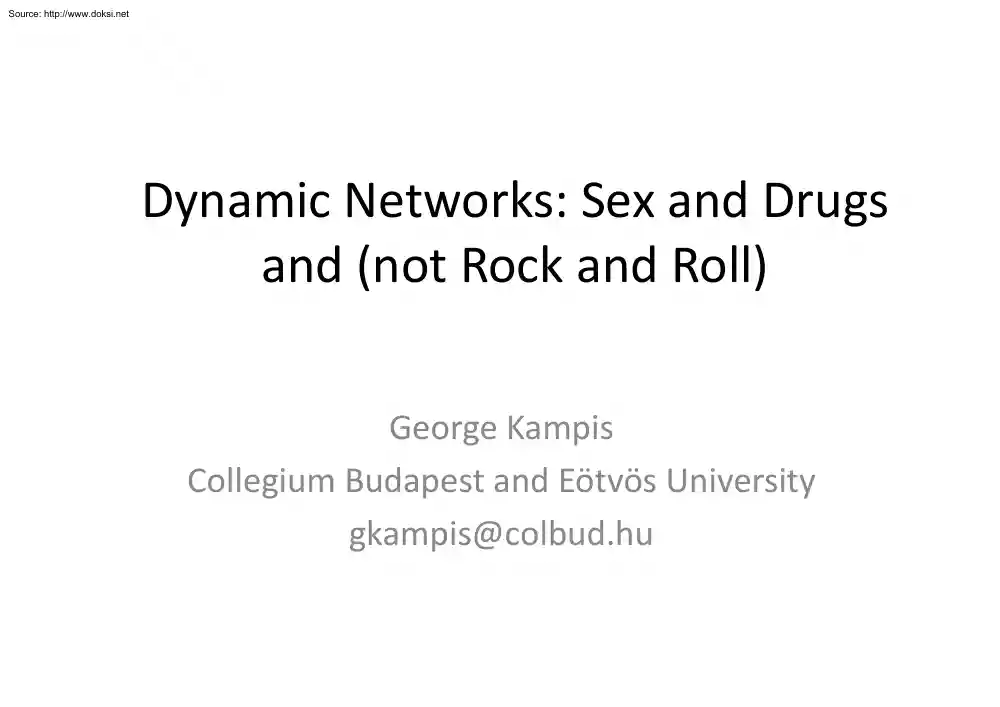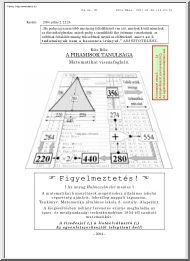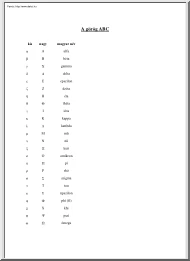Datasheet
Year, pagecount:2011, 48 page(s)
Language:English
Downloads:6
Uploaded:May 28, 2020
Size:15 MB
Institution:
-
Comments:
Collegium Budapest and Eötvös University
Attachment:-
Download in PDF:Please log in!
Comments
No comments yet. You can be the first!Content extract
Source: http://www.doksinet Dynamic Networks: Sex and Drugs and (not Rock and Roll) George Kampis Collegium Budapest and Eötvös University gkampis@colbud.hu Source: http://www.doksinet Sex & Drugs & Rock &Roll Source: http://www.doksinet Abstract: • Network science offers a suggesKve view that connects many domain sciences ranging from sociology to systems biology. Dynamic networks are the frontline of research in the field, studying situaKons where the nodes (actors) and edges (connecKons) change dynamically due to network-‐ internal (and someKmes network-‐external) reasons. The research of dynamic networks
necessitates new techniques and concepts, and overwrites much of our intuiKon and what we have learned about staKc networks so far. • For example, dynamic human contact networks invesKgated from a causal perspecKve, such as required when studying epidemics, offer radically new insights and suggesKons for disease control. Sexual contact networks and sexually transmiSed diseases (such as AIDS) provide a case we have studied extensively using modeling techniques. The lecture provides an overview of dynamic networks and focuses primarily on the sexual contacts example, to meander further
to crime networks and ecological evoluKon, which present seemingly different problems where, nevertheless, striking parallels can be drawn. Source: http://www.doksinet Today • Sexual contact networks • Crime (e.g Drug-‐growing) networks • Evolving ecosystems Source: http://www.doksinet Networks • A network: nodes + edges (ie. enKKes and relaKons) • Networks can be anything. • Network science since 1735 , 60-‐70’s. But really since 2000! Source: http://www.doksinet Power law degree distribuKon Exponent α Source: http://www.doksinet Power law is „everywhere” • V. Pareto: wealth distribuKon
G.K Zipf: word freqency, city size • Hungarian publicaKon and citaKon data 2000-‐9 Source: http://www.doksinet Or lognormal, gamma?. Long tail! 2006 „the new marketplace” Source: http://www.doksinet Average and STD in PL • Normal d. vs Powerlaw Cf. „average income”, „average number of citaKons” etc If α<2, average and STD diverge If 2 < α < 3, average is finite, STD diverges Source: http://www.doksinet Betweenness centrality • BW: number of shortest paths going through a node PL networks: hubs (i.e highest degree nodes) are highest BW nodes Source: http://www.doksinet Networks as informaKon
transmiSers • ASack PL networks: remove hubs (or highest BW) Source: http://www.doksinet And now. To sexual networks! Source: http://www.doksinet Sexual networks. hSp://www-‐personal.umichedu/~mejn/networks/ Chains of AffecKon: The Structure of Adolescent RomanKc and Sexual Networks, Peter S. Bearman, James Moody, Katherine Stovel, AJS Volume 110 Number 1 (July 2004): 44–91 An MSM network, Wales 2007 Sex Transm Infect. 2008 Oct;84(5):377-‐80 Epub 2008 Jul 2.InvesKgaKon of an HIV transmission cluster centred in South Wales.Knapper CM, Roderick J, Smith J, Temple M, Birley HD. Source: http://www.doksinet . are PL networks!
(powerlaw = „scale free”) Network of Sexual Contacts and Sexually TransmiSed HIV InfecKon in Burkina Faso, V. Latora et al., Journal of Medical Virology 78 (2006) 724 Source: http://www.doksinet InformaKon propagaKon: Epidemics on SF networks Epidemic Spreading in Scale-‐Free Networks, Romualdo Pastor-‐Satorras and Alessandro Vespignani 2001, VOLUME 86, NUMBER 14 PHYSICAL REVIEW LETTERS The spread of epidemic disease on networks, M. E J Newman, Phys Rev E 66, 016128 (2002) Epidemic threshold refers to a staKsKcal statement and it means the minimum number of cases that need to be infected in order to
assert that an epidemic (i.e spreading) is taking place. If 2 < α < 3 in an SF network, the epidemic threshold vanishes as STD diverges Ehm but we are sKll here. So Either not SF, or some other conditon is not met (e.g SIS model we did not talk about yet), or both Source: http://www.doksinet What is the α exponent in HIV? Hamilton, Deven T., Mark S Handcock and MarKna Morris (2008). Degree distribuKons in sexual networks: A framework for evaluaKng evidence. Sexually Transmi=ed Diseases, Jan. 2008 Vol. 35 No 1 What to do? • Remove the hubs. Or everybody
gets infected! • (Is this really the best advice?) Source: http://www.doksinet Sexual networks, again hSp://plaza.ufledu/garnerb/SexChartJPG Source: http://www.doksinet So, actually. Aggregate network vs „instant” network Spreading of an SI infecKon (!), hSp://csde.washingtonedu/~skyebend/betaMovies/10seed05take3mov Source: http://www.doksinet The importance of aggregaKon windows Whats in a crowd? Analysis of face-‐to-‐face behavioral networks, L. Isella et al J Theor Biol 271 (2011) 166-‐180 Kme-‐evolving degree distribuKons Source: http://www.doksinet InfecKousness = Viral load • HIV • infecKon window 0-‐3 to 9-‐12 weeks • flu, e.g
H1N1 • infecKon window 0 to 5-‐6 days Source: http://www.doksinet HIV infecKon along a causal network • Causal network = aggregated for infecKon window Source: http://www.doksinet HIV infecKon along a causal network • Causal network = aggregated for infecKon window AssortaKve mixing Source: http://www.doksinet HIV infecKon along a causal network • Causal network = aggregated for infecKon window AssortaKve mixing Source: http://www.doksinet Aggregate vs causal „SF” network • Looking at the aggregate network, we may believe it is impossible/ difficult to stop epidemic. • Now in the causal dynamics network, we have the opposite
problem: how to get a sustained infecKon at all (such as in reality)? • A soluKon: assortaKve mixing Source: http://www.doksinet Concurrency! So, to stop/prevent HIV epidemics, here is a beSer suggesKon: -‐ do not immunize/remove the hubs / high BW modes -‐ immunize/remove the highly concurrent nodes (may or may not coincide: a different parameter) Source: http://www.doksinet A sKll beSer suggesKon? Dynamic BW! „classic” betweenness is highly unstable Dynamic (snapshot) networks Aggregate network Source: http://www.doksinet Source: http://www.doksinet Drug networks! Source: http://www.doksinet Terrorist networks Source: http://www.doksinet Crime
networks Source: http://www.doksinet Can this be a crime network? Network diameter: longest path Source: http://www.doksinet „Small world” networks • Average distance (hence diameter) is VERY small in MOST known networks (but not in crime networks!) Source: http://www.doksinet Crime networks have a large diameter Source: http://www.doksinet Who to arrest to maximize damage? • Usually, many nodes are on a „criKcal path” • Again, highest BW seems to be a good candidate Source: http://www.doksinet Dynamics of social (e.g crime networks): every social network is a subnetwork Dynamic subnetwork reorganizaKon: A B C Dynamic
subnetwork reorganizaKon: B C Dynamic subnetwork reorganizaKon: B C How does knowledge of the embedding network help idenKfying the nodes to be removed? • They nodes of the embedding network are not members of the crime network (yet), so they cannot be arrested . • SelecKng the „most influenKal node” of the original crime network (to be removed) must also reflect the reorganizaKon possibiliKes • Removing the one making the largest damage, the possible reorganizaKons taken into account. • A „most influenKal node” is not (or not only) on a criKcal path (as A) but on a
criKcal path to „suitable others” (as B) • A new problem: there can be waaay too many of the laSer. • Huge embedding network, shool, prison, workplace, gym. Dynamic subnetwork reorganizaKon II: A B C Dynamic subnetwork reorganizaKon II: A C C may never be able to become part of the network any more „Workflow” model of crime: drug growing (cannabis)* Worker Master Mind Land Owner Electrician Agronomist Worker Worker Worker *folks, don’t try this at home Driver ElaboraKng the workflow Worker Master Mind Land Owner Electrician Agronomist Worker Worker Worker
Driver Workflow based crime prevenKon E D A B C Workflow based crime prevenKon E D A B C Summary and conclusion Dynamics, when taken into account, may enKrely change the way we thing about networks, e.g – InfecKon networks, such as HIV – Crime networks, such as drug growing Thank you!
necessitates new techniques and concepts, and overwrites much of our intuiKon and what we have learned about staKc networks so far. • For example, dynamic human contact networks invesKgated from a causal perspecKve, such as required when studying epidemics, offer radically new insights and suggesKons for disease control. Sexual contact networks and sexually transmiSed diseases (such as AIDS) provide a case we have studied extensively using modeling techniques. The lecture provides an overview of dynamic networks and focuses primarily on the sexual contacts example, to meander further
to crime networks and ecological evoluKon, which present seemingly different problems where, nevertheless, striking parallels can be drawn. Source: http://www.doksinet Today • Sexual contact networks • Crime (e.g Drug-‐growing) networks • Evolving ecosystems Source: http://www.doksinet Networks • A network: nodes + edges (ie. enKKes and relaKons) • Networks can be anything. • Network science since 1735 , 60-‐70’s. But really since 2000! Source: http://www.doksinet Power law degree distribuKon Exponent α Source: http://www.doksinet Power law is „everywhere” • V. Pareto: wealth distribuKon
G.K Zipf: word freqency, city size • Hungarian publicaKon and citaKon data 2000-‐9 Source: http://www.doksinet Or lognormal, gamma?. Long tail! 2006 „the new marketplace” Source: http://www.doksinet Average and STD in PL • Normal d. vs Powerlaw Cf. „average income”, „average number of citaKons” etc If α<2, average and STD diverge If 2 < α < 3, average is finite, STD diverges Source: http://www.doksinet Betweenness centrality • BW: number of shortest paths going through a node PL networks: hubs (i.e highest degree nodes) are highest BW nodes Source: http://www.doksinet Networks as informaKon
transmiSers • ASack PL networks: remove hubs (or highest BW) Source: http://www.doksinet And now. To sexual networks! Source: http://www.doksinet Sexual networks. hSp://www-‐personal.umichedu/~mejn/networks/ Chains of AffecKon: The Structure of Adolescent RomanKc and Sexual Networks, Peter S. Bearman, James Moody, Katherine Stovel, AJS Volume 110 Number 1 (July 2004): 44–91 An MSM network, Wales 2007 Sex Transm Infect. 2008 Oct;84(5):377-‐80 Epub 2008 Jul 2.InvesKgaKon of an HIV transmission cluster centred in South Wales.Knapper CM, Roderick J, Smith J, Temple M, Birley HD. Source: http://www.doksinet . are PL networks!
(powerlaw = „scale free”) Network of Sexual Contacts and Sexually TransmiSed HIV InfecKon in Burkina Faso, V. Latora et al., Journal of Medical Virology 78 (2006) 724 Source: http://www.doksinet InformaKon propagaKon: Epidemics on SF networks Epidemic Spreading in Scale-‐Free Networks, Romualdo Pastor-‐Satorras and Alessandro Vespignani 2001, VOLUME 86, NUMBER 14 PHYSICAL REVIEW LETTERS The spread of epidemic disease on networks, M. E J Newman, Phys Rev E 66, 016128 (2002) Epidemic threshold refers to a staKsKcal statement and it means the minimum number of cases that need to be infected in order to
assert that an epidemic (i.e spreading) is taking place. If 2 < α < 3 in an SF network, the epidemic threshold vanishes as STD diverges Ehm but we are sKll here. So Either not SF, or some other conditon is not met (e.g SIS model we did not talk about yet), or both Source: http://www.doksinet What is the α exponent in HIV? Hamilton, Deven T., Mark S Handcock and MarKna Morris (2008). Degree distribuKons in sexual networks: A framework for evaluaKng evidence. Sexually Transmi=ed Diseases, Jan. 2008 Vol. 35 No 1 What to do? • Remove the hubs. Or everybody
gets infected! • (Is this really the best advice?) Source: http://www.doksinet Sexual networks, again hSp://plaza.ufledu/garnerb/SexChartJPG Source: http://www.doksinet So, actually. Aggregate network vs „instant” network Spreading of an SI infecKon (!), hSp://csde.washingtonedu/~skyebend/betaMovies/10seed05take3mov Source: http://www.doksinet The importance of aggregaKon windows Whats in a crowd? Analysis of face-‐to-‐face behavioral networks, L. Isella et al J Theor Biol 271 (2011) 166-‐180 Kme-‐evolving degree distribuKons Source: http://www.doksinet InfecKousness = Viral load • HIV • infecKon window 0-‐3 to 9-‐12 weeks • flu, e.g
H1N1 • infecKon window 0 to 5-‐6 days Source: http://www.doksinet HIV infecKon along a causal network • Causal network = aggregated for infecKon window Source: http://www.doksinet HIV infecKon along a causal network • Causal network = aggregated for infecKon window AssortaKve mixing Source: http://www.doksinet HIV infecKon along a causal network • Causal network = aggregated for infecKon window AssortaKve mixing Source: http://www.doksinet Aggregate vs causal „SF” network • Looking at the aggregate network, we may believe it is impossible/ difficult to stop epidemic. • Now in the causal dynamics network, we have the opposite
problem: how to get a sustained infecKon at all (such as in reality)? • A soluKon: assortaKve mixing Source: http://www.doksinet Concurrency! So, to stop/prevent HIV epidemics, here is a beSer suggesKon: -‐ do not immunize/remove the hubs / high BW modes -‐ immunize/remove the highly concurrent nodes (may or may not coincide: a different parameter) Source: http://www.doksinet A sKll beSer suggesKon? Dynamic BW! „classic” betweenness is highly unstable Dynamic (snapshot) networks Aggregate network Source: http://www.doksinet Source: http://www.doksinet Drug networks! Source: http://www.doksinet Terrorist networks Source: http://www.doksinet Crime
networks Source: http://www.doksinet Can this be a crime network? Network diameter: longest path Source: http://www.doksinet „Small world” networks • Average distance (hence diameter) is VERY small in MOST known networks (but not in crime networks!) Source: http://www.doksinet Crime networks have a large diameter Source: http://www.doksinet Who to arrest to maximize damage? • Usually, many nodes are on a „criKcal path” • Again, highest BW seems to be a good candidate Source: http://www.doksinet Dynamics of social (e.g crime networks): every social network is a subnetwork Dynamic subnetwork reorganizaKon: A B C Dynamic
subnetwork reorganizaKon: B C Dynamic subnetwork reorganizaKon: B C How does knowledge of the embedding network help idenKfying the nodes to be removed? • They nodes of the embedding network are not members of the crime network (yet), so they cannot be arrested . • SelecKng the „most influenKal node” of the original crime network (to be removed) must also reflect the reorganizaKon possibiliKes • Removing the one making the largest damage, the possible reorganizaKons taken into account. • A „most influenKal node” is not (or not only) on a criKcal path (as A) but on a
criKcal path to „suitable others” (as B) • A new problem: there can be waaay too many of the laSer. • Huge embedding network, shool, prison, workplace, gym. Dynamic subnetwork reorganizaKon II: A B C Dynamic subnetwork reorganizaKon II: A C C may never be able to become part of the network any more „Workflow” model of crime: drug growing (cannabis)* Worker Master Mind Land Owner Electrician Agronomist Worker Worker Worker *folks, don’t try this at home Driver ElaboraKng the workflow Worker Master Mind Land Owner Electrician Agronomist Worker Worker Worker
Driver Workflow based crime prevenKon E D A B C Workflow based crime prevenKon E D A B C Summary and conclusion Dynamics, when taken into account, may enKrely change the way we thing about networks, e.g – InfecKon networks, such as HIV – Crime networks, such as drug growing Thank you!





 Just like you draw up a plan when you’re going to war, building a house, or even going on vacation, you need to draw up a plan for your business. This tutorial will help you to clearly see where you are and make it possible to understand where you’re going.
Just like you draw up a plan when you’re going to war, building a house, or even going on vacation, you need to draw up a plan for your business. This tutorial will help you to clearly see where you are and make it possible to understand where you’re going.